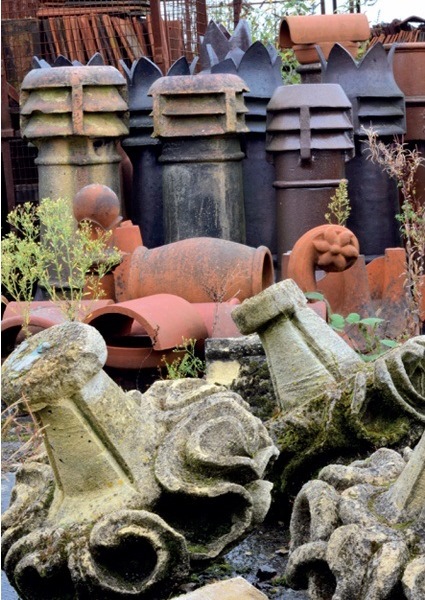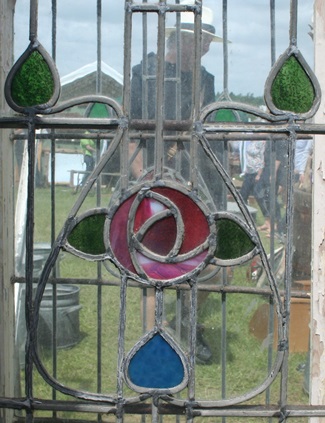Salvage and Sustainability
David Boulting
 |
|
| Some of the treasures to be found in the yard of Walcot Architectural Salvage near Bath |
‘In short, a feeble and lifeless forgery is the final result.’ This, famously, is how the 1877 manifesto of the Society for the Protection of Ancient Buildings (SPAB) described the then-fashionable Victorian practice of conjectural ‘restoration’. One can only imagine then that William Morris, one of the SPAB’s founders, would have reserved a special corner of hell for anyone who would pillage a historic element from one building and thrust it into the fabric of another.
Allowing future architectural historians, conservators and others to ‘read’ the history of a building and identify its phases of evolution and cycles of repair, remains at the heart of current good practice in conservation. Confusing a building’s biography by adding alien components is something close to sacrilege for many conservators.
However, the issues surrounding the reuse of historic materials and components in new contexts are more complex than this suggests. Like it or not, demolition of historic fabric occurs legally, often for structural reasons. Much of the material that is salvaged from these buildings is no longer available from any other source, whether because production technology has changed, or because a quarry is no longer in production, or because the timber is now endangered. In some cases there will be no suitable modern alternative, and the argument for reusing these components in conservation is compelling. Often the materials and components will also have intrinsic value – for their historic significance, their beauty or their craftsmanship – and the components themselves are worthy of protection.
In terms of environmental impact too, there is a clear imperative to reclaim and reuse material wherever practical.
SUSTAINABILITY
The environmental impacts associated with new building materials will obviously be greater than those of reclaimed materials, provided the latter can readily be made fit for purpose. It requires the energy equivalent of one gallon of petrol to produce a dozen bricks (Thornton Kay, 2014). Reclaiming good quality historic bricks, especially if they were laid using lime mortar, which is easily removed, is common sense. As Craig Jones’ introductory article points out, ‘bricks and mortar are high-carbon items but have a long lifespan. The embodied carbon of these products therefore needs to be retained for as long as possible to gain maximum value from them’.
In the case of timber, older material is often of superior quality. As Joseph Bispham explains in his article on the history and conservation of architectural timber, the architectural and joinery timber found in Britain’s historic buildings is either native hardwood or imported slow-grown softwood. In either case the timber is often of a superior quality to the faster grown softwoods available today, while modern hardwoods are expensive and are often linked to unsustainable and/or illegal forestry practices. Again, common sense dictates that such material should be reused where possible.
BACKGROUND
Architectural salvage and reclamation has a long history, and it is common to find pieces of older fabric reused in historic buildings, such as components of the abbeys and monasteries destroyed in the Reformation. More recently, the ruins at Fonthill Abbey, William Beckford’s Gothic pile near Tisbury, Wiltshire, were still being used as a source of good quality masonry around a century after its partial collapse in 1825.
Today there are hundreds of suppliers across the country specialising in reclaimed building materials, from bricks and tiles to fireplaces and larger components such as staircases. However, reclamation also covers the reuse of salvaged material elsewhere in the same building.
For example, when the National Trust recently re-roofed Grade I listed Tyntesfield House near Bristol, around 1,500 clay tiles were salvaged from the original roofs and reused on the most prominent roof slopes, while new tiles were used elsewhere.
THE NATIONAL TRUST IN NORTH WALES
The National Trust is responsible for one of the largest collections of historic buildings in the UK. The trust has made a commitment to use 20 per cent less energy, halve its fossil fuel use and generate 50 per cent of the energy it requires from renewable sources by 2020. It is also reducing its carbon footprint by making extensive use of reclaimed materials.
In North Wales this policy has resulted in a highly successful strategy of recycling materials needed for the conservation and repair of buildings across several large estates, including approximately 80 tenanted farms and cottages and a number of pay-for-entry properties and townhouses. Historic materials are only reused where there is no associated impact on the significance of the historic environment. Examples have included:
- thousands of random slates, ridge tiles and hip tiles, mainly bought from farmers who were demolishing buildings
- the purchase of complete farm buildings in the area which had been condemned for demolition
- the purchase of specific items from salvage yards, such as cast iron skylights, rainwater goods, radiators and sanitary ware.
This approach is advocated by BS7913 (2013), the latest British Standard dealing with the conservation of historic buildings:
The correct choice of materials for conservation works is important… Where possible, existing materials should be investigated and tested so that good performance and aesthetic matches can be achieved. In cases where the existing material source is not available, reuse of suitable materials from salvage might give better results than newly formed materials.
PROVENANCE
Historic material belongs to a dwindling resource that we should be safeguarding for future generations. Where there are plans to use architectural salvage, the first step should be to source materials responsibly.
Heritage crime, especially the theft of valuable components for resale, continues to be a serious problem in the UK. While lead theft (on the increase again at the time of writing) tends to dominate media coverage of heritage crime, other materials, especially building stone, are increasingly being targeted. Cases of large-scale stone theft have been steadily rising over the past two years, with a focus on areas rich in high-value building stone such as Yorkstone, Kentish Rag and Cotswold stone.
 |
||
| Early 20th-century leaded casement on the stand of De Zonneroos of Holland at the Salvo Fair 2013, Knebworth, Hertfordshire (Photo: Thornton Kay/Salvo) |
Curtilage walls such as those around churchyards are especially vulnerable. While security measures may be focussed on protecting lead roofs or valuable artefacts inside the building, cemetery walls are often directly accessible from the road, allowing irreplaceable historic stone to be stripped and loaded straight onto a flatbed lorry.
In October 2013, for example, 500 coping stones were stolen from a perimeter wall of Earnley Parish Church in West Sussex. The following month 40m2 of historic Yorkstone paving valued at £7,000 was stolen from central Rochester by thieves posing as workmen and using stolen highways barriers to make the work look legitimate.
If you have any doubts about the provenance of an item, check the theft alerts on Salvoweb (www.salvo.co.uk), where hundreds of stolen items are listed. If doubts persist it is best simply to walk away and, if there is reason to believe the item is stolen, use the 101 non-emergency police number to report it.
Salvoweb also includes a list of dealers who have signed up to the Salvo Code. There is no legal regulation of the architectural salvage trade but the code, established in 1995, has encouraged many businesses to take up voluntary self-regulation. Signatory businesses undertake to make every effort to ensure that items which they buy have not been stolen or removed from protected historic buildings without permission. Using traders who have signed up to the code demonstrates support not only for ethical traders but also for the principle of regulation itself, hopefully encouraging other businesses to follow suit.
Historically, there has been a degree of mutual distrust between the architectural salvage trade and conservation professionals. Some in the salvage trade feel it has been portrayed unfavourably despite the fact that many of those involved, especially among the more long-standing operations, are passionate both about saving historic craftsmanship from the skip and about the environmental benefits of reclamation.
Clearly, renewed efforts are necessary to build and extend cooperation between the conservation and salvage camps. In 2013 a report ‘Heritage and Cultural Property Crime National Policing Strategic Assessment’ was published by the Association of Chief Police Officers. Its conclusion includes the recommendation: ‘Improve the relationship with traders, second hand dealers, salvage firms and auctioneers in order to improve the flow of intelligence’. It remains unclear, however, how far the recommendation has progressed towards reality.
The stakes are high, both in terms of curtailing crime and promoting a healthy salvage sector. Surveys of UK salvage businesses by Salvo in 1998 and 2007 showed a large increase in the value of sales but a general decrease in the volumes of materials salvaged as the trade shifted its focus, selling more new and reproduction alternatives.
USE IT OR LOSE IT
In the 2009 edition of The Building Conservation Directory SPAB-trained architect Mark Hines made a persuasive and impassioned call for the reuse and environmental upgrading of the UK’s vast stock of unlisted Victorian and Edwardian terraced housing. Hines’ argument was in part a response to the destruction wrought by the Pathfinder Programme which, according to SAVE Britain’s Heritage, saw the demolition of some 16,000 homes which could have been refurbished.
Pathfinder saw the costly and often unpopular destruction of an increasingly scarce resource – affordable, well-built housing. Perhaps it is now time to reconsider the fate of the associated resource of historic materials and components removed during demolition or refurbishment. That they have been cast adrift from their original contexts needn’t render them worthless either as heritage or as objects with useful life left in them.
Well-established conservation principles such as maximum retention and the honesty of modern interventions are integral to the practical – as opposed to the legal – protection of historic buildings. These principles, however, may be inappropriate in the context of legally unprotected traditional buildings where more radical and imaginative interventions may be needed to improve functionality and compatibility with modern lifestyles.
~~~
Recommended Reading
R Ellis, ‘Security and Historic Buildings’, The Building Conservation Directory, Cathedral Communications, Tisbury, 2011
J Fidler, ‘Architectural Salvage: Right or Wrong’, Context, 24, The Association of Conservation Officers (now the IHBC), Guildford, 1989
L Grove and S Thomas (eds), Heritage Crime: Progress, Prospects and Prevention, Palgrave Macmillan, Basingstoke, 2014



